Umbrella Term Used to Describe European Art in the 17th 18th and 19th Centuries
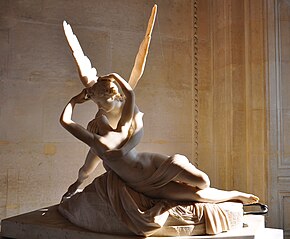
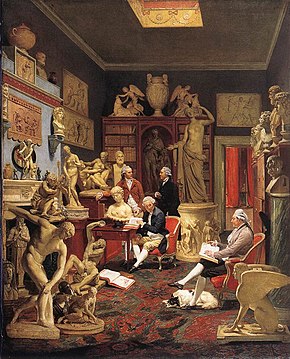
Neoclassicism (also spelled Neo-classicism) was a Western cultural movement in the decorative and visual arts, literature, theatre, music, and architecture that drew inspiration from the art and culture of classical antiquity. Neoclassicism was built-in in Rome largely thanks to the writings of Johann Joachim Winckelmann, at the time of the rediscovery of Pompeii and Herculaneum, but its popularity spread all over Europe as a generation of European art students finished their Grand Tour and returned from Italy to their domicile countries with newly rediscovered Greco-Roman ideals.[one] [2] The master Neoclassical movement coincided with the 18th-century Historic period of Enlightenment, and continued into the early 19th century, laterally competing with Romanticism. In architecture, the style continued throughout the 19th, 20th and upwards to the 21st century.
European Neoclassicism in the visual arts began c. 1760 in opposition to the and then-dominant Rococo style. Rococo compages emphasizes grace, ornamentation and asymmetry; Neoclassical architecture is based on the principles of simplicity and symmetry, which were seen as virtues of the arts of Rome and Aboriginal Greece, and were more immediately fatigued from 16th-century Renaissance Classicism. Each "neo"-classicism selects some models among the range of possible classics that are available to information technology, and ignores others. The Neoclassical writers and talkers, patrons and collectors, artists and sculptors of 1765–1830 paid homage to an idea of the generation of Phidias, just the sculpture examples they really embraced were more probable to exist Roman copies of Hellenistic sculptures. They ignored both Primitive Greek fine art and the works of Tardily Antiquity. The "Rococo" art of ancient Palmyra came as a revelation, through engravings in Wood's The Ruins of Palmyra. Even Hellenic republic was all-but-unvisited, a rough backwater of the Ottoman Empire, dangerous to explore, so Neoclassicists' appreciation of Greek architecture was mediated through drawings and engravings, which subtly smoothed and regularized, "corrected" and "restored" the monuments of Greece, non always consciously.
The Empire style, a second phase of Neoclassicism in architecture and the decorative arts, had its cultural eye in Paris in the Napoleonic era. Especially in architecture, but as well in other fields, Neoclassicism remained a force long later on the early 19th century, with periodic waves of revivalism into the 20th and even the 21st centuries, especially in the United States and Russian federation.
History [edit]
Neoclassicism is a revival of the many styles and spirit of classic antiquity inspired straight from the classical menstruum,[3] which coincided and reflected the developments in philosophy and other areas of the Age of Enlightenment, and was initially a reaction confronting the excesses of the preceding Rococo fashion.[four] While the movement is often described as the opposed counterpart of Romanticism, this is a cracking over-simplification that tends non to be sustainable when specific artists or works are considered. The case of the supposed main champion of late Neoclassicism, Ingres, demonstrates this especially well.[5] The revival tin can exist traced to the establishment of formal archaeology.[6] [vii]
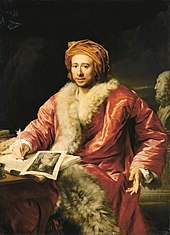
The writings of Johann Joachim Winckelmann were of import in shaping this movement in both compages and the visual arts. His books Thoughts on the Imitation of Greek Works in Painting and Sculpture (1750) and Geschichte der Kunst des Alterthums ("History of Aboriginal Art", 1764) were the kickoff to distinguish sharply betwixt Ancient Greek and Roman art, and ascertain periods within Greek fine art, tracing a trajectory from growth to maturity then false or decadence that continues to have influence to the present 24-hour interval. Winckelmann believed that fine art should aim at "noble simplicity and at-home grandeur",[9] and praised the idealism of Greek art, in which he said nosotros discover "not only nature at its most beautiful simply likewise something beyond nature, namely certain ideal forms of its beauty, which, equally an aboriginal interpreter of Plato teaches us, come from images created by the mind alone". The theory was very far from new in Western art, but his accent on close copying of Greek models was: "The only manner for us to get great or if this be possible, inimitable, is to imitate the ancients".[10]
With the advent of the Grand Tour, a fad of collecting antiquities began that laid the foundations of many great collections spreading a Neoclassical revival throughout Europe.[11] "Neoclassicism" in each fine art implies a item canon of a "classical" model.
In English, the term "Neoclassicism" is used primarily of the visual arts; the similar movement in English literature, which began considerably earlier, is called Augustan literature. This, which had been dominant for several decades, was kickoff to decline past the time Neoclassicism in the visual arts became fashionable. Though terms differ, the situation in French literature was like. In music, the period saw the rise of classical music, and "Neoclassicism" is used of 20th-century developments. However, the operas of Christoph Willibald Gluck represented a specifically Neoclassical approach, spelt out in his preface to the published score of Alceste (1769), which aimed to reform opera by removing ornamentation, increasing the role of the chorus in line with Greek tragedy, and using simpler unadorned melodic lines.[12]

The term "Neoclassical" was non invented until the mid-19th century, and at the time the fashion was described by such terms equally "the true way", "reformed" and "revival"; what was regarded as being revived varying considerably. Ancient models were certainly very much involved, but the style could likewise be regarded equally a revival of the Renaissance, and especially in France as a render to the more austere and noble Baroque of the age of Louis Fourteen, for which a considerable nostalgia had developed as French republic's dominant military and political position started a serious decline.[13] Ingres's coronation portrait of Napoleon even borrowed from Late Antique consular diptychs and their Carolingian revival, to the disapproval of critics.
Neoclassicism was strongest in compages, sculpture and the decorative arts, where classical models in the same medium were relatively numerous and attainable; examples from ancient painting that demonstrated the qualities that Winckelmann's writing found in sculpture were and are lacking. Winckelmann was involved in the dissemination of noesis of the outset large Roman paintings to be discovered, at Pompeii and Herculaneum and, like most contemporaries except for Gavin Hamilton, was unimpressed past them, citing Pliny the Younger's comments on the decline of painting in his period.[14]
As for painting, Greek painting was utterly lost: Neoclassicist painters imaginatively revived information technology, partly through bas-relief friezes, mosaics and pottery painting, and partly through the examples of painting and decoration of the High Renaissance of Raphael'south generation, frescos in Nero'due south Domus Aurea, Pompeii and Herculaneum, and through renewed admiration of Nicolas Poussin. Much "Neoclassical" painting is more classicizing in subject area matter than in annihilation else. A tearing, but frequently very badly informed, dispute raged for decades over the relative merits of Greek and Roman art, with Winckelmann and his fellow Hellenists generally being on the winning side.[15]
Painting and printmaking [edit]

Information technology is difficult to recapture the radical and exciting nature of early on Neoclassical painting for contemporary audiences; it now strikes even those writers favourably inclined to it as "insipid" and "near entirely uninteresting to us"—some of Kenneth Clark's comments on Anton Raphael Mengs' aggressive Parnassus at the Villa Albani,[xvi] past the artist whom his friend Winckelmann described as "the greatest creative person of his own, and perhaps of after times".[17] The drawings, subsequently turned into prints, of John Flaxman used very simple line drawing (thought to exist the purest classical medium[eighteen]) and figures mostly in contour to depict The Odyssey and other subjects, and one time "fired the artistic youth of Europe" merely are now "neglected",[19] while the history paintings of Angelica Kauffman, mainly a portraitist, are described as having "an unctuous softness and tediousness" by Fritz Novotny.[20] Rococo frivolity and Baroque move had been stripped away simply many artists struggled to put anything in their place, and in the absence of ancient examples for history painting, other than the Greek vases used by Flaxman, Raphael tended to exist used as a substitute model, every bit Winckelmann recommended.


The work of other artists, who could not easily exist described every bit insipid, combined aspects of Romanticism with a generally Neoclassical style, and class part of the history of both movements. The German language-Danish painter Asmus Jacob Carstens finished very few of the large mythological works that he planned, leaving mostly drawings and colour studies which often succeed in approaching Winckelmann's prescription of "noble simplicity and calm grandeur".[21] Unlike Carstens' unrealized schemes, the etchings of Giovanni Battista Piranesi were numerous and profitable, and taken back by those making the Thou Tour to all parts of Europe. His primary bailiwick matter was the buildings and ruins of Rome, and he was more stimulated by the ancient than the modern. The somewhat disquieting atmosphere of many of his Vedute (views) becomes ascendant in his series of 16 prints of Carceri d'Invenzione ("Imaginary Prisons") whose "oppressive cyclopean architecture" conveys "dreams of fearfulness and frustration".[22] The Swiss-born Johann Heinrich Füssli spent virtually of his career in England, and while his cardinal manner was based on Neoclassical principles, his subjects and handling more often reflected the "Gothic" strain of Romanticism, and sought to evoke drama and excitement.
Neoclassicism in painting gained a new sense of direction with the sensational success of Jacques-Louis David's Adjuration of the Horatii at the Paris Salon of 1785. Despite its evocation of republican virtues, this was a committee by the regal government, which David insisted on painting in Rome. David managed to combine an idealist mode with drama and forcefulness. The central perspective is perpendicular to the moving picture plane, made more than emphatic by the dim arcade behind, against which the heroic figures are disposed as in a frieze, with a hint of the bogus lighting and staging of opera, and the classical colouring of Nicolas Poussin. David rapidly became the leader of French art, and subsequently the French Revolution became a politician with control of much regime patronage in art. He managed to retain his influence in the Napoleonic catamenia, turning to bluntly propagandistic works, but had to exit France for exile in Brussels at the Bourbon Restoration.[23]
David's many students included Jean-Auguste-Dominique Ingres, who saw himself as a classicist throughout his long career, despite a mature style that has an equivocal human relationship with the main current of Neoclassicism, and many later diversions into Orientalism and the Troubadour manner that are difficult to distinguish from those of his unabashedly Romantic contemporaries, except by the primacy his works always give to drawing. He exhibited at the Salon for over lx years, from 1802 into the beginnings of Impressionism, merely his manner, once formed, changed piffling.[24]
-
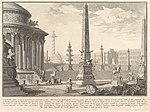
The ancient Capitol ascended by approximately one hundred steps . . .; by Giovanni Battista Piranesi; circa 1750; etching; size of the entire sheet: 33.5 × 49.4 cm; Metropolitan Museum of Art
-

Ancient Rome; by Giovanni Pauolo Panini; 1757; oil on sheet; 172.1 x 229.9 cm; Metropolitan Museum of Art
-

Aqueduct in Ruins; by Hubert Robert; 18th century; oil on canvas; 81.half-dozen 10 137.5 cm; Metropolitan Museum of Art
-

The Triumph of Aemilius Paulus; by Carle Vernet; 1789; oil on canvas; meridian; 129.ix ten 438.two cm; Metropolitan Museum of Art
-

-
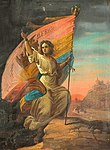
11 February 1866 - Modern Romania; past Gheorghe Tattarescu; 1866; oil on paper-thin; 31.iv x 24 cm; individual collection
Sculpture [edit]


If Neoclassical painting suffered from a lack of ancient models, Neoclassical sculpture tended to suffer from an excess of them, although examples of actual Greek sculpture of the "classical period" beginning in about 500 BC were so very few; the nigh highly regarded works were mostly Roman copies.[25] The leading Neoclassical sculptors enjoyed huge reputations in their own solar day, but are now less regarded, with the exception of Jean-Antoine Houdon, whose work was mainly portraits, very often equally busts, which do not cede a stiff impression of the sitter'due south personality to idealism. His style became more classical every bit his long career continued, and represents a rather smooth progression from Rococo charm to classical dignity. Different some Neoclassical sculptors he did not insist on his sitters wearing Roman dress, or being unclothed. He portrayed almost of the notable figures of the Enlightenment, and travelled to America to produce a statue of George Washington, as well every bit busts of Thomas Jefferson, Ben Franklin and other founders of the new republic.[26] [27]
Antonio Canova and the Dane Bertel Thorvaldsen were both based in Rome, and as well as portraits produced many ambitious life-size figures and groups; both represented the strongly idealizing tendency in Neoclassical sculpture. Canova has a lightness and grace, where Thorvaldsen is more severe; the difference is exemplified in their respective groups of the Three Graces.[28] All these, and Flaxman, were nonetheless active in the 1820s, and Romanticism was tiresome to bear upon sculpture, where versions of Neoclassicism remained the dominant style for almost of the 19th century.
An early on Neoclassicist in sculpture was the Swede Johan Tobias Sergel.[29] John Flaxman was too, or mainly, a sculptor, mostly producing severely classical reliefs that are comparable in style to his prints; he also designed and modelled Neoclassical ceramics for Josiah Wedgwood for several years. Johann Gottfried Schadow and his son Rudolph, one of the few Neoclassical sculptors to dice young, were the leading High german artists,[30] with Franz Anton von Zauner in Austria. The belatedly Bizarre Austrian sculptor Franz Xaver Messerschmidt turned to Neoclassicism in mid-career, presently earlier he appears to have suffered some kind of mental crisis, after which he retired to the land and devoted himself to the highly distinctive "character heads" of baldheaded figures pulling farthermost facial expressions.[31] Like Piranesi's Carceri, these enjoyed a nifty revival of interest during the age of psychoanalysis in the early 20th century. The Dutch Neoclassical sculptor Mathieu Kessels studied with Thorvaldsen and worked about exclusively in Rome.
Since prior to the 1830s the Usa did non have a sculpture tradition of its ain, salve in the areas of tombstones, weathervanes and send figureheads,[32] the European Neoclassical mode was adopted there, and it was to hold sway for decades and is exemplified in the sculptures of Horatio Greenough, Harriet Hosmer, Hiram Powers, Randolph Rogers and William Henry Rinehart.
-

Artemisia in mourning; by Philipp Jakob Scheffauer; 1794; marble; height: l.2 cm, width: 30 cm, depth: 5 cm; Metropolitan Museum of Fine art
-

Perseus with the head of Medusa; by Antonio Canova; 1804–1806; marble; height: 242.vi cm, width: 191.8 cm, depth: 102.9 cm; Metropolitan Museum of Art
-

Filatrice; by Henry Kirke Brown; 1850; bronze; 50.viii x 30.five 10 20.three cm; Metropolitan Museum of Art
Architecture and the decorative arts [edit]


Neoclassical art was traditional and new, historical and modernistic, conservative and progressive all at the same fourth dimension.[34]
Neoclassicism first gained influence in England and French republic, through a generation of French art students trained in Rome and influenced by the writings of Winckelmann, and it was rapidly adopted by progressive circles in other countries such as Sweden, Poland and Russian federation. At offset, classicizing decor was grafted onto familiar European forms, every bit in the interiors for Catherine 2's lover, Count Orlov, designed past an Italian architect with a team of Italian stuccadori: only the isolated oval medallions like cameos and the bas-relief overdoors hint of Neoclassicism; the furnishings are fully Italian Rococo.
A second Neoclassic wave, more astringent, more than studied (through the medium of engravings) and more consciously archaeological, is associated with the height of the Napoleonic Empire. In France, the first phase of Neoclassicism was expressed in the "Louis 16 style", and the second in the styles called "Directoire" or Empire. The Rococo style remained pop in Italy until the Napoleonic regimes brought the new archaeological classicism, which was embraced every bit a political statement past immature, progressive, urban Italians with republican leanings.[ according to whom? ]
In the decorative arts, Neoclassicism is exemplified in Empire furniture fabricated in Paris, London, New York, Berlin; in Biedermeier furniture fabricated in Republic of austria; in Karl Friedrich Schinkel'south museums in Berlin, Sir John Soane'southward Bank of England in London and the newly built "capitol" in Washington, D.C.; and in Wedgwood'southward bas reliefs and "blackness basaltes" vases. The style was international; Scots builder Charles Cameron created deluxe Italianate interiors for the German-born Catherine Ii the Great, in Russian St. Petersburg.
Indoors, Neoclassicism made a discovery of the 18-carat classic interior, inspired by the rediscoveries at Pompeii and Herculaneum. These had begun in the tardily 1740s, simply only achieved a wide audition in the 1760s,[35] with the start luxurious volumes of tightly controlled distribution of Le Antichità di Ercolano (The Antiquities of Herculaneum). The antiquities of Herculaneum showed that fifty-fifty the nigh classicizing interiors of the Baroque, or the nigh "Roman" rooms of William Kent were based on basilica and temple exterior architecture turned outside in, hence their often bombastic appearance to modern eyes: pedimented window frames turned into gilded mirrors, fireplaces topped with temple fronts. The new interiors sought to recreate an authentically Roman and genuinely interior vocabulary.
Techniques employed in the fashion included flatter, lighter motifs, sculpted in low frieze-like relief or painted in monotones en camaïeu ("similar cameos"), isolated medallions or vases or busts or bucrania or other motifs, suspended on swags of laurel or ribbon, with slender arabesques against backgrounds, perhaps, of "Pompeiian scarlet" or stake tints, or stone colors. The way in France was initially a Parisian style, the Goût grec ("Greek mode"), not a court style; when Louis XVI acceded to the throne in 1774, Marie Antoinette, his way-loving Queen, brought the "Louis Xvi" style to court. Withal, there was no existent endeavor to employ the basic forms of Roman piece of furniture until around the turn of the century, and furniture-makers were more probable to borrow from ancient compages, just as silversmiths were more than likely to accept from ancient pottery and stone-etching than metalwork: "Designers and craftsmen ... seem to have taken an almost perverse pleasance in transferring motifs from ane medium to another".[36]

From about 1800 a fresh influx of Greek architectural examples, seen through the medium of etchings and engravings, gave a new impetus to Neoclassicism, the Greek Revival. At the same time the Empire manner was a more grandiose moving ridge of Neoclassicism in compages and the decorative arts. Mainly based on Imperial Roman styles, it originated in, and took its proper name from, the dominion of Napoleon in the Starting time French Empire, where it was intended to idealize Napoleon's leadership and the French country. The manner corresponds to the more bourgeois Biedermeier style in the German-speaking lands, Federal style in the U.s.,[35] the Regency style in Great britain, and the Napoleon style in Sweden. Co-ordinate to the art historian Hugh Honour "and then far from being, as is sometimes supposed, the culmination of the Neoclassical movement, the Empire marks its rapid decline and transformation back once more into a mere antique revival, drained of all the high-minded ideas and force of conviction that had inspired its masterpieces".[37] An before stage of the way was called the Adam style in Great Britain and "Louis Seize", or Louis XVI, in France.
Neoclassicism continued to be a major strength in academic fine art through the 19th century and beyond—a abiding antithesis to Romanticism or Gothic revivals —, although from the late 19th century on information technology had frequently been considered anti-modernistic, or even reactionary, in influential critical circles.[ who? ] The centres of several European cities, notably Saint petersburg and Munich, came to look much similar museums of Neoclassical compages.
Gothic revival architecture (often linked with the Romantic cultural movement), a style originating in the 18th century which grew in popularity throughout the 19th century, contrasted Neoclassicism. Whilst Neoclassicism was characterized by Greek and Roman-influenced styles, geometric lines and order, Gothic revival architecture placed an emphasis on medieval-looking buildings, oft made to take a rustic, "romantic" appearance.
France [edit]
Louis XVI way (1760-1789) [edit]
It marks the transition from Rococo to Classicism. Different the Classicism of Louis XIV, which transformed ornaments into symbols, Louis 16 fashion represents them every bit realistic and natural as possible, ie laurel branches really are laurel branches, roses the same, and then on. One of the principal decorative principles is symmetry. In interiors, the colours used are very brilliant, including white, light grey, bright bluish, pinkish, xanthous, very calorie-free lilac, and gold. Excesses of ornament are avoided.[39] The return to antiquity is synonymous with above all with a render to the directly lines: strict verticals and horizontals were the club of the 24-hour interval. Serpentine ones were no longer tolerated, save for the occasional half circle or oval. Interior decor besides honored this taste for rigor, with the event that apartment surfaces and right angles returned to fashion. Ornamentation was used to mediate this severity, just information technology never interfered with basic lines and always was disposed symmetrically around a primal axis. Nevertheless, ébénistes often canted fore-angles to avoid excessive rigidity.[40]
The decorative motifs of Louis Xvi fashion were inspired by antiquity, the Louis Fourteen mode, and nature. Characteristic elements of the style: a torch crossed with a sheath with arrows, imbricated disks, guilloché, double bow-knots, smoking braziers, linear repetitions of small motifs (rosettes, chaplet, oves), trophy or floral medallions hanging from a knotted ribbon, acanthus leaves, gadrooning, interlace, meanders, cornucopias, mascarons, Ancient urns, tripods, perfume burners, dolphins, ram and lion heads, chimeras, and gryphons. Greco-Roman architectural motifs are too very used: flutings, pilasters (fluted and unfluted), fluted balusters (twisted and straight), columns (engaged and unengaged, sometimes replaced by caryathids), volute corbels, triglyphs with guttae (in relief and trompe-fifty'œil).[41]
-

-

-

Large vase; 1783; difficult porcelain and gold bronze; meridian: ii yard, bore: 0.90 m; Louvre
-

Ringlet-top desk of Marie-Antoinette; by Jean-Henri Riesener; 1784; oak and pine frame, sycamore, amaranth and rosewood veneer, bronze gold; 103.6 x 113.iv cm; Louvre[l]
-
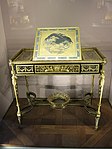
Writing table of Marie-Antoinette; by Adam Weisweiler; 1784; oak, ebony and sycamore veneer, Japanese lacquer, steel, statuary gilt; 73.vii ten 81. ii cm; Louvre[51]
-

Ewer; 1784–1785; silverish; meridian: 32.9 cm; Metropolitan Museum of Fine art
-

Folding stool (pliant); 1786; carved and painted beechwood, covered in pink silk; 46.4 × 68.6 × 51.4 cm; Metropolitan Museum of Fine art
-

Pair of vases; 1789; hard-paste porcelain, gilt statuary, marble; height (each): 23 cm; Metropolitan Museum of Art
-
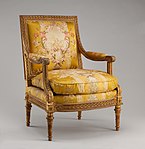
Armchair (fauteuil) from Louis XVI's Salon des Jeux at Saint Cloud; 1788; carved and aureate walnut, gold brocaded silk (non original); overall: 100 × 74.9 × 65.i cm; Metropolitan Museum of Art
Empire manner (1804-1815) [edit]

It representative for the new French society that has exited from the revolution which set the tone in all life fields, including art. The Jacquard automobile is invented during this period (which revolutionises the entire sewing system, transmission until then). 1 of the ascendant colours is ruby-red, decorated with gilt bronze. Bright colours are also used, including white, cream, violet, brown, bleu, dark ruddy, with petty ornaments of gilt bronze. Interior architecture includes forest panels decorated with gilt reliefs (on a white background or a coloured one). Motifs are placed geometrically. The walls are covered in stuccos, wallpaper pr fabrics. Fireplace mantels are made of white marble, having caryatids at their corners, or other elements: obelisks, sphinxes, winged lions, and then on. Bronze objects were placed on their tops, including mantel clocks. The doors consist of unproblematic rectangular panels, decorated with a Pompeian-inspired primal figure. Empire fabrics are damasks with a bleu or dark-brown background, satins with a greenish, pink or purple background, velvets of the same colors, brooches broached with aureate or silverish, and cotton fabrics. All of these were used in interiors for defunction, for covering certain article of furniture, for cushions or upholstery (leather is besides used for upholstery).[52]
All Empire ornamentation is governed by a rigorous spirit of symmetry reminiscent of the Louis 14 mode. Mostly, the motifs on a slice'south correct and left sides represent to one some other in every particular; when they don't, the individual motifs themselves are entirely symmetrical in composition: antiquarian heads with identical tresses falling onto each shoulder, frontal figures of Victory with symmetrically arrayed tunics, identical rosettes or swans flanking a lock plate, etc. Like Louis XIV, Napoleon had a gear up of emblems unmistakably associated with his dominion, about notably the hawkeye, the bee, stars, and the initials I (for Imperator) and N (for Napoleon), which were usually inscribed inside an purple laurel crown. Motifs used include: figures of Victory bearing palm branches, Greek dancers, nude and draped women, figures of antiquarian chariots, winged putti, mascarons of Apollo, Hermes and the Gorgon, swans, lions, the heads of oxen, horses and wild beasts, butterflies, claws, winged chimeras, sphinxes, bucrania, body of water horses, oak wreaths knotted by sparse trailing ribbons, climbing grape vines, poppy rinceaux, rosettes, palm branches, and laurel. There's a lot of Greco-Roman ones: stiff and flat acanthus leaves, palmettes, cornucopias, beads, amphoras, tripods, imbricated disks, caduceuses of Mercury, vases, helmets, burning torches, winged trumpet players, and aboriginal musical instruments (tubas, rattles and especially lyres). Despite their antique derivation, the fluting and triglyphs so prevalent nether Louis 16 are abandoned. Egyptian Revival motifs are especially common at the showtime of the menses: scarabs, lotus capitals, winged disks, obelisks, pyramids, figures wearing nemeses, caryatids en gaine supported by bare feet and with women Egyptian headdresses.[53]
-

-

Washstand (athénienne or lavabo); 1800–1814; legs, base and shelf of yew wood, golden-bronze mounts, iron plate beneath shelf; elevation: 92.four cm, width: 49.v cm; Metropolitan Museum of Art
-

-

Clock with Mars and Venus; circa 1810; gilded bronze and patina; height: ninety cm; Louvre
-

Carpet; 1814–1830; 309.9 × 246.4 cm; Metropolitan Museum of Art
The Great britain [edit]
Adam style [edit]
The Adam manner was created past two brothers, Adam and James, who published in 1777 a book of etchings with interior ornamentation. In the interior decoration made subsequently Robert Adam'southward drawings, the walls, ceilings, doors, and any other surface, are divided into large panels: rectangular, round, foursquare, with stuccos and Greco-Roman motifs at the edges. Ornaments used include festoons, pearls, egg-and-dart bands, medallions, and any other motifs used during the Classical antiquity (especially the Etruscan ones). Decorative fittings such equally urn-shaped stone vases, gilded silverware, lamps, and stauettes all have the aforementioned source of inspiration, classical antiquity.
The Adam manner emphasizes refined rectangular mirrors, framed like paintings (in frames with stylised leafs), or with a pediment to a higher place them, supporting an urn or a medallion. Some other blueprint of Adam mirrors is shaped like a Venetian window, with a big primal mirror betwixt 2 other thinner and longer ones. Another type of mirrors are the oval ones, usually decorated with festoons. The article of furniture in this style has a like construction to Louis XVI furniture.[58]
-

-

Rectangular mirror with a modest urn at the top; by Robert Adam; 1765; carved and painted pine and drinking glass; overall: 355.6 × 190.5 cm; Metropolitan Museum of Art (New York City)
-

The Hall (Osterley Park), 1767, by Robert Adam[61]
-

Carpeting; by Robert Adam; 1770–1780; knotted wool; 505.5 x 473.1 cm; Metropolitan Museum of Art
-

Urn on pedestal; circa 1780 with latter additions; by Robert Adam; inlaid mahogany; height: 49.8 cm; Metropolitan Museum of Fine art
-

Side table with many acanthus leafs and two bucrania; by Robert Adam; circa 1780 with later addition; mahogany; overall: 88.6 × 141.iii × 57.1 cm; Metropolitan Museum of Art
The U.s.a. [edit]
Federal style [edit]
On the American continent, compages and interior ornamentation have been highly influenced by the styles developed in Europe. The French taste has highly marked its presence in the southern states (after the French Revolution some emigrants have moved here, and in Canada a big part of the population has French origins). The practical spirit and the textile situation of the Americans at that time gave the interiors a typic atmosphere. All the American furniture, carpets, tableware, ceramic, and silverware, with all the European influences, and sometimes Islamic, Turkish or Asian, were fabricated in conformity with the American norms, taste, and functional requirements. In that location have existed in the The states a menstruation of the Queen Anne style, and an Chippendale one. A way of its own, the Federal style, has developed completely in the 18th and early 19th centuries, which has flourished being influenced by Britannic sense of taste. Under the impulse of Neoclassicism, architecture, interiors, and piece of furniture have been created. The style, although it has numerous characteristics which differ from state to state, is unitary. The structures of architecture, interiors, and furniture are Classicist, and contain Baroque and Rococo influences. The shapes used include rectangles, ovals, and crescents. Stucco or wooden panels on walls and ceilings reproduce Classicist motifs. Furniture tend to exist decorated with floral marquetry and bronze or brass inlays (sometimes gilded).[62]
-

Candlestand; 1790-1800; mahogany, birch, and diverse inlays; 107 x 49.21 10 48.9 cm; Los Angeles Canton Museum of Art
-

Writing desk-bound; 1790-1810; satinwood, mahogany, tulip poplar, and pine; 153.67 x xc.17 x 51.44 cm; Los Angeles County Museum of Art
-

-

Armchair; perhaps by Ephraim Haines; 1805-1815; mahogany and cane; peak: 84.77 cm, width: 52.07 cm; Los Angeles County Museum of Fine art
-

Four-column pedestal bill of fare table with pineapple finial; 1815-1820; mahogany, tulip poplar, and pine woods; 74.93 x 92.71 ten 46.67 cm; Los Angeles Canton Museum of Art
-

Gardens [edit]
In England, Augustan literature had a directly parallel with the Augustan way of landscape blueprint. The links are conspicuously seen in the work of Alexander Pope. The best surviving examples of Neoclassical English language gardens are Chiswick House, Stowe House and Stourhead.[63]
Neoclassicism and fashion [edit]

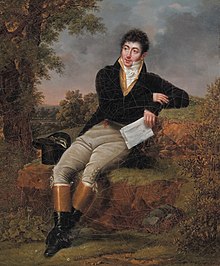
In fashion, Neoclassicism influenced the much greater simplicity of women's dresses, and the long-lasting fashion for white, from well before the French Revolution, simply information technology was not until afterwards it that thorough-going attempts to imitate ancient styles became stylish in France, at least for women. Classical costumes had long been worn past stylish ladies posing equally some figure from Greek or Roman myth in a portrait (in particular there was a rash of such portraits of the young model Emma, Lady Hamilton from the 1780s), but such costumes were merely worn for the portrait sitting and masquerade balls until the Revolutionary period, and perhaps, like other exotic styles, every bit undress at abode. Just the styles worn in portraits by Juliette Récamier, Joséphine de Beauharnais, Thérésa Tallien and other Parisian trend-setters were for going-out in public as well. Seeing Mme Tallien at the opera, Talleyrand quipped that: "Il n'est pas possible de s'exposer plus somptueusement!" ("One could non be more sumptuously undressed"). In 1788, just before the Revolution, the court portraitist Louise Élisabeth Vigée Le Brun had held a Greek supper where the ladies wore obviously white Grecian tunics.[64] Shorter classical hairstyles, where possible with curls, were less controversial and very widely adopted, and pilus was now uncovered fifty-fifty outdoors; except for evening clothes, bonnets or other coverings had typically been worn even indoors before. Sparse Greek-fashion ribbons or fillets were used to tie or decorate the hair instead.
Very low-cal and loose dresses, ordinarily white and often with shockingly blank arms, rose sheer from the ankle to just below the bodice, where in that location was a strongly emphasized thin hem or tie round the torso, often in a different colour. The shape is now often known as the Empire silhouette although information technology predates the Beginning French Empire of Napoleon, but his commencement Empress Joséphine de Beauharnais was influential in spreading it around Europe. A long rectangular shawl or wrap, very oftentimes plain red but with a decorated border in portraits, helped in colder weather, and was patently laid around the midriff when seated—for which sprawling semi-recumbent postures were favoured.[65] Past the start of the 19th century, such styles had spread widely across Europe.
Neoclassical style for men was far more problematic, and never actually took off other than for hair, where it played an of import role in the shorter styles that finally despatched the use of wigs, and so white pilus-powder, for younger men. The trouser had been the symbol of the barbarian to the Greeks and Romans, but outside the painter's or, especially, the sculptor's studio, few men were prepared to abandon it. Indeed, the menses saw the triumph of the pure trouser, or pantaloon, over the culotte or genu-breeches of the Ancien Régime. Fifty-fifty when David designed a new French "national costume" at the asking of the authorities during the summit of the Revolutionary enthusiasm for irresolute everything in 1792, information technology included fairly tight leggings under a glaze that stopped higher up the genu. A high proportion of well-to-do young men spent much of the key period in military machine service because of the French Revolutionary Wars, and military uniform, which began to emphasize jackets that were brusk at the forepart, giving a full view of tight-fitting trousers, was often worn when not on duty, and influenced civilian male styles.
The trouser-problem had been recognised by artists as a bulwark to creating contemporary history paintings; similar other elements of contemporary clothes they were seen every bit irredeemably ugly and unheroic past many artists and critics. Various stratagems were used to avoid depicting them in modern scenes. In James Dawkins and Robert Wood Discovering the Ruins of Palmyra (1758) by Gavin Hamilton, the two admirer antiquaries are shown in toga-like Arab robes. In Watson and the Shark (1778) by John Singleton Copley, the main figure could plausibly be shown nude, and the composition is such that of the eight other men shown, only ane shows a single breeched leg prominently. However the Americans Copley and Benjamin Due west led the artists who successfully showed that trousers could be used in heroic scenes, with works like Westward's The Death of General Wolfe (1770) and Copley's The Death of Major Peirson, half-dozen Jan 1781 (1783), although the trouser was still being carefully avoided in The Raft of the Medusa, completed in 1819.
Classically inspired male person hair styles included the Bedford Crop, arguably the precursor of most plain modern male styles, which was invented past the radical politician Francis Russell, 5th Knuckles of Bedford as a protest against a tax on hair powder; he encouraged his friends to adopt it past betting them they would not. Another influential mode (or group of styles) was named by the French "à la Titus" after Titus Junius Brutus (not in fact the Roman Emperor Titus as often causeless), with hair short and layered only somewhat piled upwardly on the crown, often with restrained quiffs or locks hanging down; variants are familiar from the hair of both Napoleon and George IV of the United Kingdom. The style was supposed to have been introduced past the player François-Joseph Talma, who upstaged his wigged co-actors when appearing in productions of works such as Voltaire's Brutus (about Lucius Junius Brutus, who orders the execution of his son Titus). In 1799 a Parisian way mag reported that even baldheaded men were adopting Titus wigs,[66] and the manner was also worn by women, the Journal de Paris reporting in 1802 that "more than than one-half of elegant women were wearing their hair or wig à la Titus.[67]
Later Neoclassicism [edit]

In American architecture, Neoclassicism was one expression of the American Renaissance motility, ca. 1890–1917; its final manifestation was in Beaux-Arts architecture, and its final large public projects were the Lincoln Memorial (highly criticized at the fourth dimension), the National Gallery of Art in Washington, D.C. (also heavily criticized by the architectural community as beingness backward thinking and quondam fashioned in its design), and the American Museum of Natural History's Roosevelt Memorial. These were considered stylistic anachronisms when they were finished. In the British Raj, Sir Edwin Lutyens' monumental metropolis planning for New Delhi marks the sunset of Neoclassicism. World State of war II was to shatter about longing for (and fake of) a mythical time.
Conservative modernist architects such as Auguste Perret in French republic kept the rhythms and spacing of columnar architecture even in factory buildings. Where a pillar would take been decried as "reactionary", a building's pilaster-like fluted panels nether a repeating frieze looked "progressive". Pablo Picasso experimented with classicizing motifs in the years immediately following World War I, and the Fine art Deco way that came to the fore following the 1925 Paris Exposition des Arts Décoratifs, often drew on Neoclassical motifs without expressing them overtly: astringent, blocky commodes by É.-J. Ruhlmann or Süe & Mare; crisp, extremely low-relief friezes of damsels and gazelles in every medium; stylish dresses that were draped or cutting on the bias to recreate Grecian lines; the fine art dance of Isadora Duncan; the Streamline Moderne styling of U.S. postal service offices and county court buildings built as late as 1950; and the Roosevelt dime.
At that place was an unabridged 20th-century motion in the Arts which was as well called Neoclassicism. It encompassed at least music, philosophy and literature. It was betwixt the end of World State of war I and the end of World War II. (For information on the musical aspects, run into 20th-century classical music and Neoclassicism in music. For information on the philosophical aspects, see Great Books.)
This literary Neoclassical movement rejected the extreme romanticism of (for example) Dada, in favour of restraint, religion (specifically Christianity) and a reactionary political program. Although the foundations for this movement in English language literature were laid past T. East. Hulme, the virtually famous Neoclassicists were T. S. Eliot and Wyndham Lewis. In Russian federation, the movement crystallized every bit early on as 1910 under the name of Acmeism, with Anna Akhmatova and Osip Mandelshtam as the leading representatives.
In music [edit]
Neoclassicism in music is a 20th-century motion; in this case information technology is the Classical and Baroque musical styles of the 17th and 18th centuries, with their fondness for Greek and Roman themes, that were being revived, non the music of the ancient world itself. (The early 20th century had not still distinguished the Baroque period in music, on which Neoclassical composers mainly drew, from what we at present call the Classical period.) The motion was a reaction in the beginning function of the 20th century to the disintegrating chromaticism of late-Romanticism and Impressionism, emerging in parallel with musical Modernism, which sought to abandon key tonality altogether. It manifested a desire for cleanness and simplicity of style, which allowed for quite dissonant paraphrasing of classical procedures, but sought to blow abroad the cobwebs of Romanticism and the twilit glimmerings of Impressionism in favour of bold rhythms, assertive harmony and groomed exclusive forms, coinciding with the faddy for reconstructed "classical" dancing and costume in ballet and physical education.
The 17th-18th century trip the light fantastic toe suite had had a pocket-size revival before World War I but the Neoclassicists were non altogether happy with unmodified diatonicism, and tended to emphasise the brilliant dissonance of suspensions and ornaments, the angular qualities of 17th-century modal harmony and the energetic lines of countrapuntal office-writing. Respighi's Ancient Airs and Dances (1917) led the manner for the sort of audio to which the Neoclassicists aspired. Although the exercise of borrowing musical styles from the past has non been uncommon throughout musical history, fine art musics take gone through periods where musicians used modern techniques coupled with older forms or harmonies to create new kinds of works. Notable compositional characteristics are: referencing diatonic tonality, conventional forms (dance suites, concerti grossi, sonata forms, etc.), the idea of absolute music untramelled past descriptive or emotive associations, the use of light musical textures, and a conciseness of musical expression. In classical music, this was most notably perceived between the 1920s and the 1950s. Igor Stravinsky is the best-known composer using this style; he finer began the musical revolution with his Bach-like Octet for Wind Instruments (1923). A item individual work that represents this style well is Prokofiev'south Classical Symphony No. i in D, which is reminiscent of the symphonic style of Haydn or Mozart. Neoclassical ballet every bit innovated past George Balanchine de-cluttered the Russian Imperial mode in terms of costume, steps and narrative, while also introducing technical innovations.
Architecture in Russia and the Soviet Marriage [edit]

In 1905–1914 Russian architecture passed through a cursory but influential menstruum of Neoclassical revival; the trend began with recreation of Empire fashion of alexandrine menstruation and quickly expanded into a variety of neo-Renaissance, Palladian and modernized, still recognizably classical schools. They were led past architects born in the 1870s, who reached artistic peak before World State of war I, similar Ivan Fomin, Vladimir Shchuko and Ivan Zholtovsky. When economic system recovered in the 1920s, these architects and their followers continued working in primarily modernist environment; some (Zholtovsky) strictly followed the classical canon, others (Fomin, Schuko, Ilya Golosov) adult their own modernized styles.[68]

With the crackdown on architects independence and official deprival of modernism (1932), demonstrated by the international competition for the Palace of Soviets, Neoclassicism was instantly promoted as i of the choices in Stalinist architecture, although non the only selection. It coexisted with moderately modernist architecture of Boris Iofan, bordering with contemporary Art Deco (Schuko); again, the purest examples of the way were produced by Zholtovsky school that remained an isolated phenomena. The political intervention was a disaster for constructivist leaders nonetheless was sincerely welcomed by architects of the classical schools.
Neoclassicism was an piece of cake choice for the USSR since it did not rely on modern structure technologies (steel frame or reinforced concrete) and could exist reproduced in traditional masonry. Thus the designs of Zholtovsky, Fomin and other former masters were easily replicated in remote towns under strict cloth rationing. Improvement of construction applied science after World State of war Ii permitted Stalinist architects to venture into skyscraper construction, although stylistically these skyscrapers (including "exported" architecture of Palace of Culture and Science, Warsaw and the Shanghai International Convention Centre) share lilliputian with the classical models. Neoclassicism and neo-Renaissance persisted in less demanding residential and role projects until 1955, when Nikita Khrushchev put an end to expensive Stalinist architecture.
Architecture in the 21st century [edit]
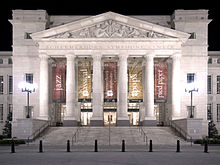
Later on a lull during the period of modern architectural dominance (roughly post-Earth State of war Two until the mid-1980s), Neoclassicism has seen something of a resurgence.
As of the outset decade of the 21st century, contemporary Neoclassical architecture is normally classed under the umbrella term of New Classical Compages. Sometimes information technology is also referred to as Neo-Historicism or Traditionalism.[69] Also, a number of pieces of postmodern compages describe inspiration from and include explicit references to Neoclassicism, Antigone Commune and the National Theatre of Catalonia in Barcelona amidst them. Postmodern architecture occasionally includes historical elements, similar columns, capitals or the tympanum.
For sincere traditional-mode architecture that sticks to regional architecture, materials and craftsmanship, the term Traditional Architecture (or vernacular) is more often than not used. The Driehaus Architecture Prize is awarded to major contributors in the field of 21st century traditional or classical compages, and comes with a prize money twice every bit loftier every bit that of the modernist Pritzker Prize.[lxx]
In the Usa, various contemporary public buildings are built in Neoclassical style, with the 2006 Schermerhorn Symphony Center in Nashville being an example.
In Uk, a number of architects are active in the Neoclassical style. Examples of their work include 2 university libraries: Quinlan Terry's Maitland Robinson Library at Downing College and Robert Adam Architects' Sackler Library.
Run across also [edit]
- 1795–1820 in Western style
- American Empire (style)
- Antiquization
- Nazi architecture
- Neoclassicism in French republic
- Neo-Grec, the late Greek-Revival style
- Skopje 2014
Notes [edit]
- ^ Stevenson, Angus (2010-08-19). Oxford Dictionary of English. ISBN9780199571123.
- ^ Kohle, Hubertus (August 7, 2006). "The road from Rome to Paris. The nascency of a modernistic Neoclassicism". Jacques Louis David. New perspectives.
- ^ Irwin, David Thousand. (1997). Neoclassicism A&I (Fine art and Ideas) . Phaidon Press. ISBN978-0-7148-3369-nine.
- ^ Honor, 17-25; Novotny, 21
- ^ A recurring theme in Clark: nineteen-23, 58-62, 69, 97-98 (on Ingres); Laurels, 187-190; Novotny, 86-87
- ^ Lingo, Estelle Cecile (2007). François Duquesnoy and the Greek ideal. Yale University Press; First Edition. pp. 161. ISBN978-0-300-12483-5.
- ^ Talbott, Page (1995). Classical Savannah: fine & decorative arts, 1800-1840. Academy of Georgia Press. p. 6. ISBN978-0-8203-1793-nine.
- ^ Cunningham, Reich, Lawrence South., John J. (2009). Culture and values: a survey of the humanities. Wadsworth Publishing; 7 edition. p. 104. ISBN978-0-495-56877-3.
- ^ Honour, 57-62, 61 quoted
- ^ Both quotes from the first pages of "Thoughts on the Imitation of Greek Works in Painting and Sculpture"
- ^ Dyson, Stephen L. (2006). In Pursuit of Aboriginal Pasts: A History of Classical Archaeology in the Nineteenth and Twentieth Centuries. Yale University Press. pp. xii. ISBN978-0-300-11097-5.
- ^ Honor, 21
- ^ Honor, xi, 23-25
- ^ Accolade, 44-46; Novotny, 21
- ^ Honour, 43-62
- ^ Clark, 20 (quoted); Award, fourteen; image of the painting (in fairness, other works past Mengs are more successful)
- ^ Honour, 31-32 (31 quoted)
- ^ Honour, 113-114
- ^ Accolade, 14
- ^ Novotny, 62
- ^ Novotny, 51-54
- ^ Clark, 45-58 (47-48 quoted); Honour, 50-57
- ^ Honour, 34-37; Clark, 21-26; Novotny, 19-22
- ^ Novotny, 39-47; Clark, 97-145; Laurels, 187-190
- ^ Novotny, 378
- ^ Novotny, 378–379
- ^ Chinard, Gilbert, ed., Houdon in America Arno PressNy, 1979, a reprint of a book published by Johns Hopkins Academy, 1930
- ^ Novotny, 379-384
- ^ Novotny, 384-385
- ^ Novotny, 388-389
- ^ Novotny, 390-392
- ^ Gerdts, William H., American Neo-Archetype Sculpture: The Marble Resurrection, Viking Press, New York, 1973 p. eleven
- ^ Fine art ● Architecture ● Painting ● Sculpture ● Graphics ● Design. 2011. p. 313. ISBN978-1-4454-5585-3.
- ^ Palmer, Alisson Lee. Historical dictionary of neoclassical art and architecture. p. 1.
- ^ a b Gontar
- ^ Honour, 110–111, 110 quoted
- ^ Honour, 171–184, 171 quoted
- ^ Jones 2014, p. 273.
- ^ Graur, Neaga (1970). Stiluri în arta decorativă (in Romanian). Cerces. pp. 200, 201 & 202.
- ^ Sylvie, Chadenet (2001). French Furniture • From Louis XIII to Fine art Deco. Picayune, Brown and Company. p. 71.
- ^ Sylvie, Chadenet (2001). French Furniture • From Louis XIII to Art Deco. Fiddling, Brown and Company. p. 72.
- ^ de Martin 1925, p. xi.
- ^ Jones 2014, p. 276.
- ^ de Martin 1925, p. 13.
- ^ Jacquemart, Albert (2012). Decorative Art. Parkstone. p. 65. ISBN978-1-84484-899-7.
- ^ Larbodière, Jean-Marc (2015). 50'Architecture de Paris des Origins à Aujourd'hui (in French). Massin. p. 105. ISBN978-2-7072-0915-iii.
- ^ de Martin 1925, p. 17.
- ^ "Corner Cabinet - The Art Institute of Chicago".
- ^ de Martin 1925, p. 61.
- ^ Jacquemart, Albert (2012). Decorative Art. Parkstone. p. 61. ISBN978-1-84484-899-seven.
- ^ Jacquemart, Albert (2012). Decorative Fine art. Parkstone. p. 61. ISBN978-1-84484-899-7.
- ^ Graur, Neaga (1970). Stiluri în arta decorativă (in Romanaian). Cerces. pp. 217, 219, 220 & 221.
- ^ Sylvie, Chadenet (2001). French Furniture • From Louis Xiii to Fine art Deco. Little, Chocolate-brown and Company. p. 103 & 105.
- ^ Jones 2014, p. 275.
- ^ a b Hopkins 2014, p. 111.
- ^ Odile, Nouvel-Kammerer (2007). Symbols of Ability • Napoleon and the Art of the Empire Style • 1800-1815. p. 209. ISBN978-0-8109-9345-7.
- ^ Odile, Nouvel-Kammerer (2007). Symbols of Power • Napoleon and the Art of the Empire Style • 1800-1815. p. 32. ISBN978-0-8109-9345-seven.
- ^ Graur, Neaga (1970). Stiluri în arta decorativă (in Romanian). Cerces. pp. 253, 255 & 256.
- ^ a b Hopkins 2014, p. 103.
- ^ Bailey 2012, pp. 226. sfn error: no target: CITEREFBailey2012 (help)
- ^ Fortenberry 2017, p. 274.
- ^ Graur, Neaga (1970). Stiluri în arta decorativă (in Romanian). Cerces. pp. 269, 270, & 271.
- ^ Turner, Turner (2013). British gardens: history, philosophy and blueprint, Chapter 6 Neoclassical gardens and landscapes 1730-1800. London: Routledge. p. 456. ISBN978-0415518789.
- ^ Hunt, 244
- ^ Chase, 244-245
- ^ Chase, 243
- ^ Rifelj, 35
- ^ "The Origins of Modernism in Russian Architecture". Content.cdlib.org. Retrieved 2012-02-12 .
- ^ "Neo-classicist Compages. Traditionalism. Historicism".
- ^ Driehaus Prize for New Classical Architecture at Notre Matriarch SoA – Together, the $200,000 Driehaus Prize and the $50,000 Reed Laurels stand for the almost significant recognition for classicism in the gimmicky built environment.; retained March 7, 2014
References [edit]
- Clark, Kenneth, The Romantic Rebellion: Romantic versus Classic Art, 1976, Omega. ISBN 0-86007-718-seven.
- de Martin, Henry (1925). Le Way Louis Sixteen (in French). Flammarion.
- Fortenberry, Diane (2017). The Art Museum (Revised ed.). London: Phaidon Printing. ISBN978-0-7148-7502-6. Archived from the original on 2021-04-23. Retrieved 2021-04-23 .
- Gontar, Cybele (2000–). "Neoclassicism". Heilbrunn Timeline of Art History. New York: The Metropolitan Museum of Art.
- Hopkins, Owen (2014). Architectural Styles: A Visual Guide. Laurence Male monarch. ISBN978-178067-163-five.
- Honour, Hugh (1968). Neo-classicism. Mode and Civilization. Penguin. . Reprinted 1977.
- Hunt, Lynn (1998). "Freedom of Dress in Revolutionary French republic". In Melzer, Sara E.; Norberg, Kathryn (eds.). From the Purple to the Republican Body: Incorporating the Political in Seventeenth- and Eighteenth-Century France. Academy of California Press. ISBN9780520208070.
- Jones, Denna, ed. (2014). Architecture The Whole Story. Thames & Hudson. ISBN978-0-500-29148-1.
- Novotny, Fritz. Painting and Sculpture in Europe, 1780–1880 (2nd (reprinted 1980) ed.).
- Rifelj, Carol De Dobay (2010). Coiffures: Hair in Nineteenth-Century French Literature and Culture. Academy of Delaware Printing. ISBN9780874130997.
Further reading [edit]
- Brown, Kevin (2017). Creative person and Patrons: Court Art and Revolution in Brussels at the finish of the Ancien Regime, Dutch Crossing, Taylor and Francis
- Eriksen, Svend. Early Neoclassicism in France (1974)
- Friedlaender, Walter (1952). David to Delacroix (originally published in German; reprinted 1980)
- Gromort, Georges, with introductory essay by Richard Sammons (2001). The Elements of Classical Architecture (Classical America Series in Art and Architecture)
- Harrison, Charles; Paul Forest and Jason Gaiger (eds) (2000; repr. 2003). Art in Theory 1648–1815: An Anthology of Changing Ideas
- Hartop, Christopher, with foreword past Tim Knox (2010). The Classical Platonic: English Silver, 1760–1840, exh. cat. Cambridge: John Adamson ISBN 978-0-9524322-nine-six
- Irwin, David (1966). English language Neoclassical Art: Studies in Inspiration and Taste
- Johnson, James William. "What Was Neo-Classicism?" Journal of British Studies, vol. 9, no. 1, 1969, pp. 49–70. online
- Rosenblum, Robert (1967). Transformations in Late Eighteenth-Century Art
External links [edit]
- Neoclassicism in the "History of Art"
- "Neoclassicism Fashion Guide". British Galleries. Victoria and Albert Museum. Retrieved 2007-07-17 .
- Neo-classical drawings in the Flemish Art Drove
- 19th Century Sculpture Derived From Greek Hellenistic Influence: Jacob Ungerer
- The Neoclassicising of Pompeii
Source: https://en.wikipedia.org/wiki/Neoclassicism

0 Response to "Umbrella Term Used to Describe European Art in the 17th 18th and 19th Centuries"
Post a Comment